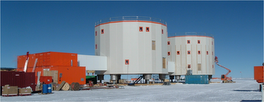Two conversations of interest to polar seismology...
During the afternoon of the last day of the European Geophysical Union meeting in Vienna, I had two very interesting conversations, one with a member of the IRIS-PASSCAL polar team, and the other with a friendly glaciologist I knew from Concordia.
The polar team at IRIS-PASSCAL have done all the development and part of the deployment of the American experiments in Antarctica for the International Polar Year. Their station designs are first rate, and their success rate for last season makes me envious (23 out of 24 stations deployed worked perfectly, sending state of health data over satellite links). We exchanged design details, and did some troubleshooting for some of the instruments at Concordia. One very interesting, motivating and helpful conversation!
Just afterwards, I bumped into a glaciologist from LGGE in Grenoble, who I met for the first time at Concordia, two years ago. We got talking about the ice structure around Dome C (quite a lot is known thanks to the EPICA ice core), and how it may influence the seismic data we record up there. He gave me a good overview of how compaction works, and suggested some people who might know more about the mechanical properties of the various ice layers, their density and possibly their wavespeeds. This might help us figure out how to correct for the ice-signal on or recorded seismograms.
Just an example of how putting a bunch of scientists and technical people in a conference center together can turn out to be hugely profitable, often in unpredictable ways.
The polar team at IRIS-PASSCAL have done all the development and part of the deployment of the American experiments in Antarctica for the International Polar Year. Their station designs are first rate, and their success rate for last season makes me envious (23 out of 24 stations deployed worked perfectly, sending state of health data over satellite links). We exchanged design details, and did some troubleshooting for some of the instruments at Concordia. One very interesting, motivating and helpful conversation!
Just afterwards, I bumped into a glaciologist from LGGE in Grenoble, who I met for the first time at Concordia, two years ago. We got talking about the ice structure around Dome C (quite a lot is known thanks to the EPICA ice core), and how it may influence the seismic data we record up there. He gave me a good overview of how compaction works, and suggested some people who might know more about the mechanical properties of the various ice layers, their density and possibly their wavespeeds. This might help us figure out how to correct for the ice-signal on or recorded seismograms.
Just an example of how putting a bunch of scientists and technical people in a conference center together can turn out to be hugely profitable, often in unpredictable ways.




No comments:
Post a Comment